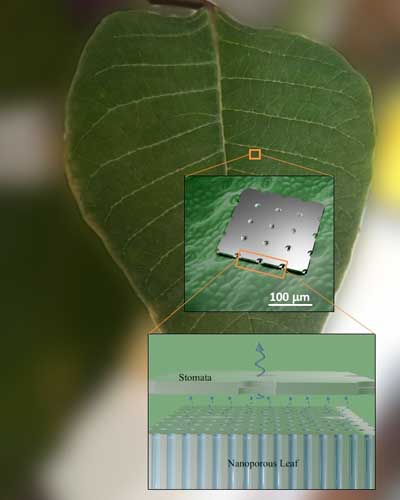| Jul 01, 2020 | |
Stabilizing water loss in synthetic trees(Nanowerk News) Scientists are developing “synthetic trees” that work like their natural counterparts to serve in specific applications. In an important step, scientists fabricated synthetic leaves using nanoporous disks. These disks control moisture at the scale of molecules to mimic natural transpiration, the life-sustaining water cycle plants use to absorb and release moisture. |
|
| The disks use a novel, layered design topped with silicon pores to trap water vapor. They help synthetic plants control moisture loss and prevent drying in low-humidity environments. | |
| By drawing on the way natural trees function, synthetic trees have potential uses in a wide range of energy and water applications. For example, they could pump water or cool buildings without machinery. However, they tend to dry out below certain humidity levels. This has limited their development. | |
 |
|
| Researchers fabricated synthetic, moisture-controlling leaves that resist drying in low humidity. (Image: Oak Ridge National Laboratory) | |
| New micro- and nanofabrication methods open routes to reproducible, cost-effective synthetic trees that are practical for variable, real-world environments. | |
| Synthetic trees have potential applications in passive water and energy harvesting, but this potential has been limited by cost and performance issues. The tendency for synthetic systems to dry out in low humidity inhibits wider use in everyday applications where conditions are variable. | |
| To address this drawback, researchers demonstrated approaches to avoiding drying. This opens practical routes to effective and affordable systems. | |
| In the new research (ACS Appl. Mater. Interfaces, "Self-Stabilizing Transpiration in Synthetic Leaves"), scientists fabricated synthetic leaves with novel vapor-trapping layers, featuring silicon micro-chambers atop a wetted, nanoporous disk. The chambers on the top layer mimic the “stomata” or pores in natural leaves that open and close to regulate water retention, while the disk layer simulates natural leaf tissue. | |
| The inclusion of pores, generally not seen in other designs, greatly increased overall performance. The stomata-based design showed promising results for self-stabilizing when exposed to dry air. For a less complex and lower cost option, researchers also demonstrated that the nanoporous disk alone, without the silicon chambers on top, effectively managed humidity and reduced the amount of drying by retaining moisture within the nanopore structure. |
| Source: Center for Nanophase Materials Sciences, Oak Ridge National Laboratory | |
|
Subscribe to a free copy of one of our daily Nanowerk Newsletter Email Digests with a compilation of all of the day's news. |
